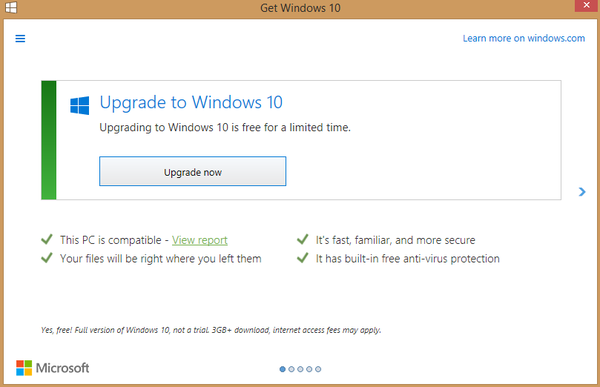Why Microsoft is pushing Windows 10 hard
Microsoft's new operating system, released on July 29, 2015, has been available for nearly five months at the time of writing.
It is offered as a free upgrade on systems running Windows 7 or Windows 8.1, and available as a standalone retail copy or installed on retail PCs.
Adoption rates are good but not excellent. Microsoft revealed adoption figures sporadically only, last time in October 2015 during Microsoft's Devices Event when it mentioned that Windows 10 was driving 110 million consumer and Enterprise PCs.
The company has been tight lipped ever since and while that may simply be because of a lack of events where it could reveal new figures to a worldwide audience, it may also be because adoption rates are dropping.
Microsoft's Goal
Microsoft's ambitious goal, announced during the Build 2015 conference, is to have Windows 10 on over 1 billion devices two to three years after the official release of the operating system.
To reach the goal in two years, Microsoft would have to push 1.369 million copies of Windows 10 on devices worldwide, and for the three year goal, it would still be 1.005 million copies each day.
Adoption rates have been good in the first couple of months, thanks to the free offer but adoption seems to slow down if usage stats are anything to go by.
Microsoft mentioned devices and not PCs when it revealed the goal which indicates that Windows 10 on any platform counts towards that goal. Since Windows 10 will be made available for Windows Phone, Microsoft's Xbox One, tablets, and other devices, it makes it more likely that the goal will be reached after all.
There will likely be a big push at the end of the free for a year period as (some) consumers may want to take advantage of the free upgrade offer after all before it expires.
Windows 10 or die

credit Hayden Dingman
Microsoft is betting big on Windows 10, that it will be a success, and that its one operating system core to fit them all strategy will work out fine.
If Windows 10 fails, Microsoft would be in a terrible position. It could produce Windows 11, even though it announced previously that there would be no such thing, and adjust it accordingly to make it more attractive to consumers and Enterprise customers.
But since everything is entangled now thanks to the one core OS strategy, it would be difficult to change that course especially if time is of the essence.
For Microsoft, Windows 10 must succeed, there is no other option, and that is one of the reasons why the operating system is pushed hard.
Things will heat up in the coming months, and some users are already seeing that in form of new upgrade dialogs that show no "no thanks" option anymore but only options to upgrade to Windows 10.
It is unclear how far Microsoft will go, whether it will push Windows 10 as an important update via its Windows Update service for instance, or if it will refrain from doing so as it would certainly cause backlash.
Now You: How far will Microsoft go to push Windows 10?